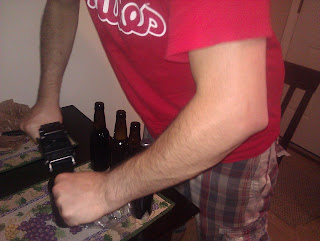This past weekend I tried to build a stir plate, as well as a Son-of-Fermentation chiller. It didn't go so well.
The Fermentation Chiller
If you aren't familiar with what this is, it is basically a box built from thick styrofoam - the kind you would use to insulate your house. The inside of the box is split into 2 compartments, separated by a partition with 2 holes cut in it. Your carboy sits in the big compartment, with a thermostat. The smaller compartment contains jug(s) of ice; you can use milk jugs, coffee cans, apple juice jugs... whatever.
 |
| The ice goes on the left, carboy on the right. The top, front, and right side are not displayed here |
The thermostat is hooked up to a CPU fan. Set the thermostat to whatever temperature makes sense for your batch, figure 62° F for an ale. When the temperature gets too high, the thermostat turns on the CPU fan which sucks air from the compartment where the carboy is sitting, down over the jugs of ice (thus cooling the air) and back into the carboy compartment. This is basically how an air conditioner works, except there is no compressor, and no freon.
Now I didn't come up with this myself, I'm not that clever. I read about it on HBT and eventually found the "
plans" to build it by this guy named Ken Schwartz.
I put "plans" in quotes there because although Ken seems to know what he is talking about, the plans and the PDF is terribly organized. I was expecting to see something like 1) Equipment list 2) Diagram 3) Step-by-step instructions. There is some degree of organization but all in all it is poorly written. Having worked in tech support for 6 of the last 7 years, this made me cry a little bit inside.
That being said, there is enough information in the PDF and from other folks at HBT that I was able to figure out how this all works. The first thing I did was pick up a thermostat, CPU fan, and 12V adapter. I probably could have gotten an adapter from someone for free but I was too excited so I went out and bought one.
My first problem came with the wiring. I'm no electrician, I understand enough to not get myself killed but that's about it. I had some trouble figuring out which wires go where, but now I'm pretty much a genius. If anyone ever needs a CPU fan hooked up to a thermostat - I'm your guy!
cpu fan hooked up to the thermostat
Once I figured out the CPU-thermostat-power supply setup, I tested it out. I was pretty excited about the whole thing working. I felt like I invented fire. My girlfriend was as equally uninterested as I was excited, she promptly returned to watching her DVR'd
Bachelorette.
I went to Lowes and picked up 2" thick polystyrene (fancy word for styrofoam). The
jerks nice people at Lowes wouldn't cut it for me. They handed me a utility knife and a ruler and said have fun.
It was not fun.
After jamming my first cut up pieces of foam into my car in the pouring rain, I got home and tried putting this thing together. I failed miserably
this is what happened with my first attempt. not quite a fermentation chiller...
I wound up having to go back to get a 2nd 4x8 piece of foam. I asked them to cut this piece, and they agreed this time around. Right now, everything is stuck together and looks like it might work out, but I won't be able to find out until some time tomorrow.
It's together, for now. Time to see if this thing works!
Stir Plate
The other project I set out to do was a home made stir plate. After reading a bunch of articles on yeast starters, the stir plate seemed like a cool thing to have. On Amazon, the real deal stir plates are at least $80-$100, fuck that.
I started reading around the HBT DIY forums and everyone on there said it would be nice and easy to build one. It's just a magnet on a fan! I couldn't find the right type of magnets, and I suck at precision so I have a fan with a hard drive magnet stuck on it, that can't spin shit right now.
[Pic of my stir plate coming]
I eventually gave up and just
bought one. I'm pretty sure this is just some guy who made it himself, since he is only selling them for $45. Payment was made through PayPal so I'm confident that my information is secure.
I bought it Saturday evening and already got notification that it has been shipped, so hopefully it will arrive some time this week and I can see how it works out.













